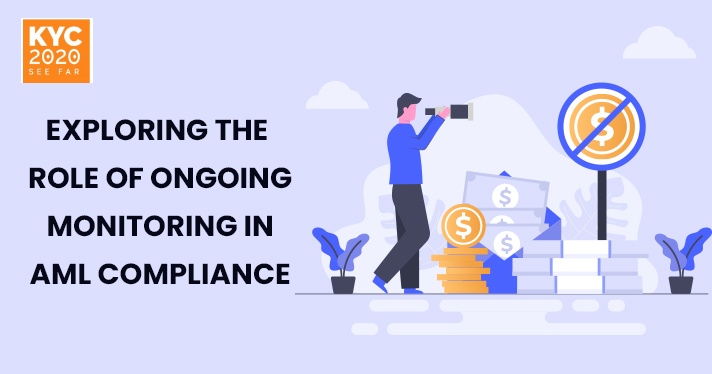In today’s rapidly evolving financial landscape, the fight against money laundering has become more crucial than ever before. To safeguard the integrity of the global financial system, financial institutions are increasingly turning to anti-money laundering – AML compliance measures. However, the role of ongoing monitoring often goes unnoticed. In this blog, we will delve into the importance of ongoing monitoring and its significant contribution to AML compliance, exploring its benefits, regulatory requirements, and potential to strengthen compliance programs.
We will uncover ongoing monitoring enhances the detection of hidden risks, leverages technology, and promotes collaboration, ultimately ensuring a more robust and resilient AML compliance framework.
Enhancing AML Compliance Efforts through Continuous Vigilance
The AML compliance program is an ongoing process requiring continuous vigilance to combat money laundering activities effectively. Ongoing monitoring is a critical tool in this regard, enabling financial institutions to detect and mitigate potential risks. Its ongoing monitoring casts a wider net, primarily on individual data, ensuring that suspicious activities and patterns are identified over time.
Uncovering Hidden Risks: The Power of Ongoing Monitoring
Ongoing monitoring is pivotal in uncovering hidden risks that may otherwise go undetected. Financial institutions can gain deeper insights into potential money laundering activities by analyzing customer behavior and account activity over an extended period. This proactive approach helps identify anomalies, unusual trends, and suspicious relationships that might indicate illicit financial behavior. It empowers institutions to take timely action, preventing the further proliferation of money laundering schemes.
Leveraging Technology for Effective Ongoing Monitoring
The effective implementation of ongoing monitoring relies heavily on technology-driven solutions. Advanced analytics, artificial intelligence, and machine learning algorithms can help financial institutions sift through vast amounts of data, identifying patterns and anomalies that might signal money laundering activities. These technologies enable the automation of monitoring processes, enhancing efficiency and reducing the risk of human error. By harnessing the power of technology, institutions can stay ahead of increasingly sophisticated money laundering techniques.
The Importance of Collaboration and Information Sharing
Ongoing monitoring is not limited to an individual institution’s efforts but extends to collaboration and information sharing among financial institutions and regulatory bodies. Through sharing information on suspicious activities, emerging risks, and new typologies, institutions can collectively strengthen their AML compliance efforts. Collaboration facilitates the identification of broader trends and helps develop more robust risk mitigation strategies, ultimately contributing to a stronger and more resilient financial system.
Strengthening Compliance Programs: The Benefits of Ongoing Monitoring
Implementing robust ongoing monitoring practices not only ensures regulatory compliance but also brings several benefits to financial institutions. Below we are mentioning some of the benefits:
- It enables institutions to protect their reputation by minimizing the risk of involvement in money laundering activities. By actively monitoring customer behavior, institutions can identify and address potential risks, thereby safeguarding their integrity and preserving the trust of their customers and stakeholders.
- Ongoing monitoring contributes to cost-effectiveness in AML compliance efforts. Detecting and mitigating risks early can prevent financial losses, regulatory penalties, and reputational damage associated with non-compliance. By proactively identifying and addressing potential money laundering activities, institutions can avoid the financial implications of fines and legal consequences.
- Ongoing monitoring enhances the overall effectiveness of AML compliance programs. It enables institutions to refine their risk assessments, adjust monitoring strategies, and improve the accuracy of their suspicious activity reporting. The insights gained from ongoing monitoring help institutions stay one step ahead of money launderers, adapting to new and evolving techniques.
The Regulatory Landscape: Ongoing Monitoring as a Requirement
Regulatory bodies worldwide are placing increased emphasis on the importance of ongoing monitoring in AML compliance. Financial institutions are obligated to implement robust monitoring programs. These regulatory requirements acknowledge the necessity of continuous vigilance in the fight against money laundering.
Regulators expect financial institutions to demonstrate a proactive and risk-based approach to ongoing monitoring. Integrating ongoing monitoring into compliance programs is essential to meet regulatory expectations and ensure adherence to AML laws and regulations.
Non-compliance with regulatory requirements can have severe consequences for financial institutions. Apart from financial penalties, institutions may face reputational damage, loss of customer trust, and even legal repercussions. Therefore, incorporating ongoing monitoring practices into AML compliance programs is not just a regulatory obligation but a fundamental requirement for financial institutions’ long-term sustainability and success.
How KYC2020 Can Help Implementing Ongoing Monitoring of AML
KYC2020 is a trusted partner that helps financial institutions achieve and maintain compliance through its comprehensive ongoing monitoring solutions.
We provide financial institutions with robust and scalable technology enabling real-time activity monitoring. By leveraging SanctionWatch, an advanced KYC AML compliance tool, the institutions can quickly analyze large volumes of data, identify suspicious patterns, and detect potential money laundering activities in real-time. This proactive approach ensures that financial institutions can promptly respond to and mitigate potential risks, helping them comply with evolving AML regulations.
SanctionWatch is designed to minimize false positives, which can burden compliance teams and hinder operational efficiency. It also offers robust data integration capabilities. It aggregates data from multiple sources, including international sanctions lists and adverse media, providing a comprehensive view of customer risk profiles. By harnessing this broad range of data, financial institutions can enhance their monitoring efforts, ensuring they capture all relevant information and minimize the risk of missing critical red flags.
Furthermore, Staying current with regulatory requirements is crucial to maintaining compliance and avoiding penalties or reputational damage. SanctionWatch™ is continuously updated with the latest regulatory changes and additions to sanctions lists, ensuring that financial institutions are always up to date with the evolving compliance landscape.
Hence, by partnering with KYC2020, financial institutions can benefit from continuous support and ensure their ongoing monitoring practices align with changing regulatory landscapes.
Conclusion
Ongoing monitoring plays a vital role in AML compliance, serving as a proactive tool to identify and mitigate risks associated with money laundering. By continuously monitoring customer behavior, transactional patterns, and account activity, financial institutions can uncover hidden risks and take timely action. Leveraging technology and promoting collaboration among institutions are crucial factors in maximizing the effectiveness of ongoing monitoring. As financial systems continue to evolve, ongoing monitoring will remain an indispensable component of AML compliance, safeguarding the integrity of the global financial system.






